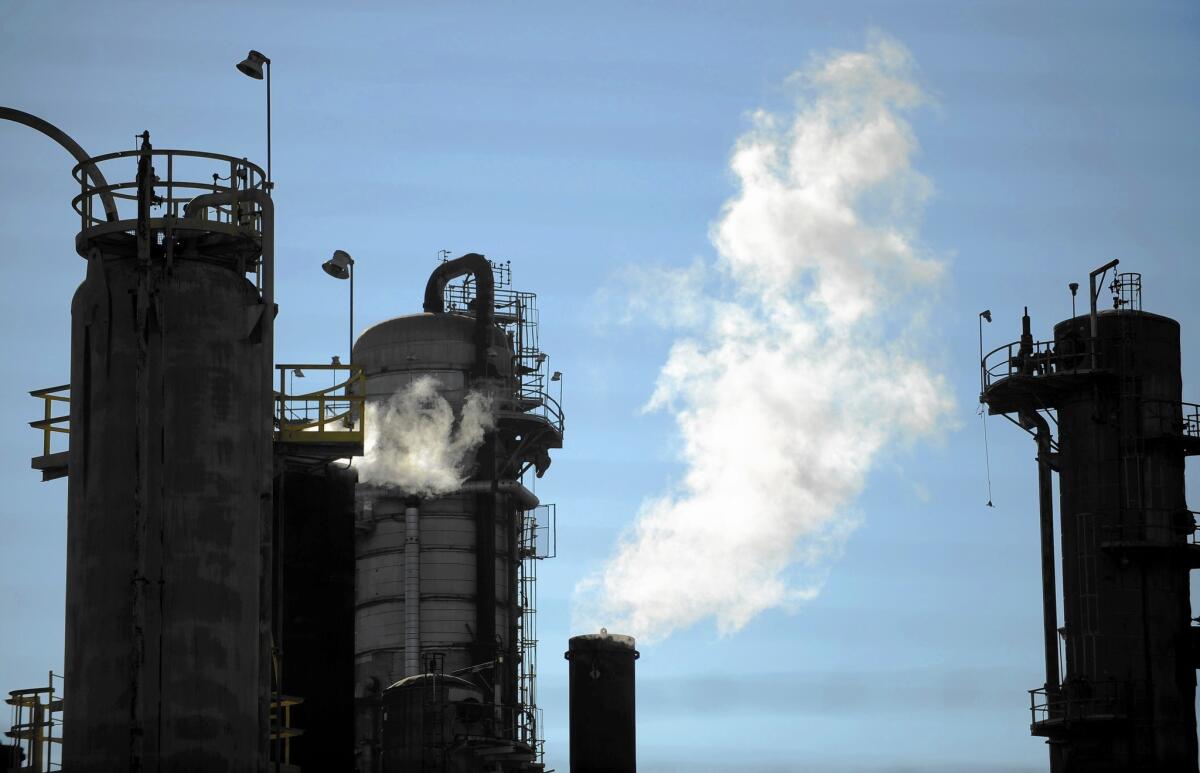Lower L.A. gas prices coming soon? Exxon Mobil is poised to increase output at Torrance refinery

- Share via
Exxon Mobil’s plan to increase production at its Torrance refinery appears on track for approval, which could help lower gasoline prices in the Los Angeles region within weeks.
The latest schedule would bring Exxon Mobil Corp. before the South Coast Air Quality Management District on Thursday seeking permission to use an old pollution-control system to replace one destroyed in an explosion at the Torrance plant in February.
The old equipment releases more pollutants than the one lost in February, but Exxon Mobil promises mitigation steps that will help guard public health. The proposal includes operating the refinery at 80% to 85% of its full capacity.
Increasing production at the Torrance plant, which provides 10% of the state’s capacity and 20% in Southern California, is seen as a key to lowering gasoline prices in the Los Angeles area.
NEWSLETTER: Get the day’s top headlines from Times Editor Davan Maharaj >>
The average gasoline price in the region remained $1 to $1.50 higher than the U.S. average for much of the summer because of troubled refineries — Torrance in particular — and low inventories.
“Good news is on the horizon,” said Gordon Schremp, a senior fuels specialist at the California Energy Commission. “The question is, how soon might we see relief?”
Exxon Mobil has been working to connect the old pollution-control system and other maintenance projects in preparation for bringing the facility back online, Schremp said.
Todd Spitler, an Exxon Mobil spokesman, declined to discuss specific actions but did say that “maintenance continues as we work cooperatively with South Coast AQMD on a potential restart plan.”
In Schremp’s estimation, if approval comes after next week’s hearing, the refinery could increase production by the end of September or early October.
Couple that with a switch from California’s summer blend of gasoline to the winter blend on Nov. 1, and Schremp believes that the average price statewide could reach within 50 cents of the national average.
The U.S. Energy Information Administration projects the national average price for a gallon of regular gasoline will be $2.03 by December. In Schremp’s ideal scenario, that would bring the average price for a gallon of gasoline in California to $2.53.
Jamie Court, president of the advocacy group Consumer Watchdog, said that while Exxon Mobil’s plan to use the old pollution control is not ideal, consumers throughout California need relief from the high gasoline prices they have endured.
“This is a Faustian bargain,” Court said. “This is a bargain with the devil. Our inventories are chronically low. Exxon’s got a gun to our heads. It’s a no-win situation.”
Regulators rescheduled a hearing before the South Coast Air Quality Management District this week for the second time as the agency continues to ensure that Exxon Mobil’s plan poses no threat to the health of nearby residents.
SIGN UP for the free California Inc. business newsletter >>
The agency hasn’t received any opposition to Exxon Mobil’s proposal to use the old pollution-control system, but it is ensuring the plan is feasible, said Sam Atwood, a spokesman for the management district.
“This is our job, to protect public health,” he said.
If the management district rejects Exxon Mobil’s plan, the refinery might not fully restore operations until mid-February, Atwood said. That also could force the refinery to lay off workers as a result of low production.
The refinery employs about 650 staff members and 550 contractors.
“We know that the refinery likely cannot continue to employ a full contingent of staff” without soon increasing production, Atwood said. “It’s just simple economics of any business.”
Torrance Mayor Patrick Furey said the city is depending on the management district’s expertise about whether Exxon Mobil’s strategy is safe for the community.
“We have to rely upon the experts,” Furey said. “We’ve met with Exxon Mobil a number of times since the incident. We just follow it very closely. Obviously we’re concerned about safety.”
After the February incident, Exxon Mobil has operated the Torrance plant at less than 20% of its normal capacity.
Some analysts had expected the Torrance refinery to return to full service by July 1. When Torrance’s production didn’t increase, gasoline prices jumped. Some L.A. gasoline stations posted prices of more than $5 a gallon as inventories ran low.
On a normal day, the Torrance plant, which sits on 750 acres, processes an average of 155,000 barrels of crude oil and produces 1.8 billion gallons of gasoline a year.
But the explosion at the plant Feb. 18 destroyed a pollution-control unit that stands 12 stories tall.
The old pollution-control system was never removed, so Exxon Mobil has been working to reconnect it to the refining operation to increase production as soon as possible, Schremp said.
“Any production — 50%, 60% — will be good,” Schremp said.
Twitter: @ivanlpenn
ALSO:
Producer prices unchanged in August as gas costs fall
Chinese visits to U.S. are expected to grow despite China’s economic woes
David Lazarus: United Airlines CEO Jeff Smisek’s golden parachute adds to fliers’ frustration
More to Read
Inside the business of entertainment
The Wide Shot brings you news, analysis and insights on everything from streaming wars to production — and what it all means for the future.
You may occasionally receive promotional content from the Los Angeles Times.










